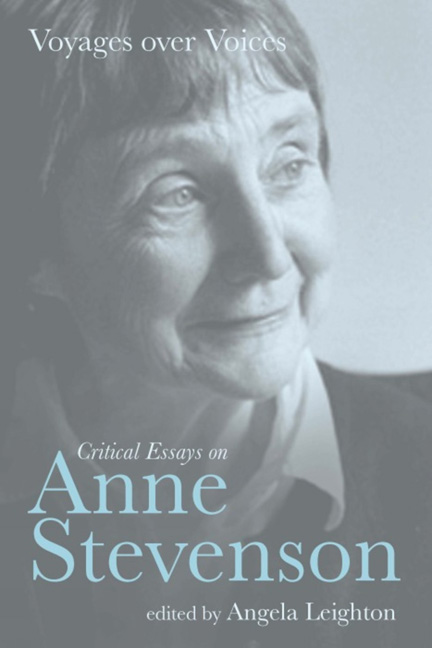Book contents
- Frontmatter
- Contents
- Notes on Contributors
- Acknowledgements
- ‘Making Poetry’
- 1 ‘Voyages over voices’: Introduction
- 2 The Melting Metaphor
- 3 ‘Between us’: Letters and Poems of Stevenson and Bishop
- 4 Mothers, Mirrors, Doubles: Anne Stevenson's Elegies for Sylvia Plath
- 5 Staging Second Thoughts: The Poetry of Anne Stevenson
- 6 ‘Making Poetry’: The Exemplary Anne Stevenson
- 7 ‘A curved adventure’: Romanticism and the Poetry of Anne Stevenson
- 8 The Nature of Anne Stevenson
- 9 Anne Stevenson and the Poetry of Place
- 10 Compacting Time: Anne Stevenson's Poems of Memory
- 11 ‘Not exactly a persona’: Pronouns in Anne Stevenson's Poetry
- 12 ‘To serve a girl on terrible terms’: Anne Stevenson's Writing Selves
- 13 Talking and Singing: Anne Stevenson's Variations on a Rhythmical Theme
- 14 ‘Time will erase’: Anne Stevenson and Elegy
- 15 Observing the Overhearing: The Anne Stevenson Papers in Cambridge University Library
- 16 Bibliography of Anne Stevenson's Published Works
- General Index
- Index of Stevenson's Works
13 - Talking and Singing: Anne Stevenson's Variations on a Rhythmical Theme
- Frontmatter
- Contents
- Notes on Contributors
- Acknowledgements
- ‘Making Poetry’
- 1 ‘Voyages over voices’: Introduction
- 2 The Melting Metaphor
- 3 ‘Between us’: Letters and Poems of Stevenson and Bishop
- 4 Mothers, Mirrors, Doubles: Anne Stevenson's Elegies for Sylvia Plath
- 5 Staging Second Thoughts: The Poetry of Anne Stevenson
- 6 ‘Making Poetry’: The Exemplary Anne Stevenson
- 7 ‘A curved adventure’: Romanticism and the Poetry of Anne Stevenson
- 8 The Nature of Anne Stevenson
- 9 Anne Stevenson and the Poetry of Place
- 10 Compacting Time: Anne Stevenson's Poems of Memory
- 11 ‘Not exactly a persona’: Pronouns in Anne Stevenson's Poetry
- 12 ‘To serve a girl on terrible terms’: Anne Stevenson's Writing Selves
- 13 Talking and Singing: Anne Stevenson's Variations on a Rhythmical Theme
- 14 ‘Time will erase’: Anne Stevenson and Elegy
- 15 Observing the Overhearing: The Anne Stevenson Papers in Cambridge University Library
- 16 Bibliography of Anne Stevenson's Published Works
- General Index
- Index of Stevenson's Works
Summary
During an interview with the Cortland Review Anne Stevenson declared ‘poetry has to either sing or talk’. That poetry may ‘talk’ rather than ‘sing’ might seem a surprising concession from a poet whose work is distinguished by its exceptional musicality. In much of her commentary, too, Stevenson emphasises the importance she assigns to the rhythmic and auditory qualities of language. However, it has always struck me as over-simple to define her work as exclusively lyrical. Certainly to regard her as a formalist, ‘new’ or otherwise, implying a poet with narrow, metrical criteria of poetic rhythm, is wide of the mark. For all the eloquence with which Stevenson depicts herself as a somewhat beleaguered defender of the melodic tradition against the tin-eared gabbling of the Zeitgeist, close reading often reveals a subtle mediation between the kind of poetry that talks and the kind that sings.
Of course, we are most likely to remember those of her poems that are straightforwardly song-like: the ballads, sonnets, villanelles, and other forays into the ‘fixed’ forms whose distant origins lie in music and dance. Their very design on us is mnemonic. Far more characteristic ally, in fact, Stevenson works in stanzaic structures not dictated by a particular form. These stanzas are usually, but by no means invariably, symmetrical. They may be rhymed or para-rhymed, and they may rhyme across the stanza break, but they frequently avoid predictable or seemingly pre-set rhyme schemes. It is not unusual for Stevenson to interrupt the rhyming pattern she has established, or otherwise to blur its outline. In an exquisite poem from the early 1980s, ‘Walking Early by the Wye’, the six tercets rhyme AAB CCB, and so on, with the third lines rhyming in pairs across the stanza break:
Through dawn in February's wincing radiance,
every splinter of river mist
rayed in my eyes.
As if the squint of the sun had released light's
metals. As if the river pulsed white,
and the holly's
sharp green lacquered leaves leaped acetylene.
(p. 64)- Type
- Chapter
- Information
- Voyages over VoicesCritical Essays on Anne Stevenson, pp. 191 - 205Publisher: Liverpool University PressPrint publication year: 2010



